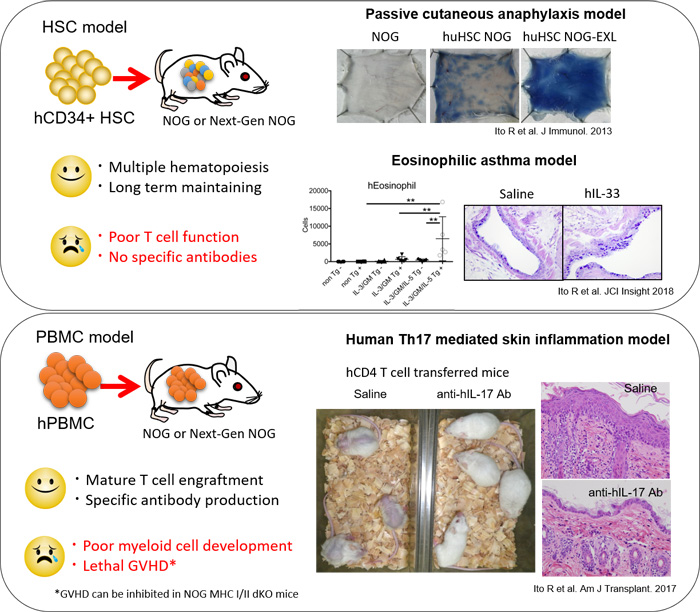Human Disease Model Laboratory
Currently, rodent models are the gold standard in most fields of biomedical research due to their small size, large litters, and ease of maintenance, handling, and reproductive engineering.
However, they cannot fully recapitulate the physiological and pathological mechanisms underlying most human diseases because the expression level or functional status of the molecules
frequently differ between human and rodent cells.
In human disease model laboratory, we have been creating innovative humanized mouse which are reconstituted with human hematopoietic and immune cells
by transferring human CD34+ HSCs or PBMCs to recapitulate various human diseases including allergic, infectious, and autoimmune diseases, GVHD and etc.
These models can be used to analyze in vivo onset mechanisms of human diseases and to apply preclinical evaluation of the efficacy and safety of novel drugs.
We can provide those powerful tools to facilitate basic/applied biomedical research in worldwide.

※References
-
Chemically defined cytokine-free expansion of human haematopoietic stem cells.
Sakurai M, Ishitsuka K, Ito R, Wilkinson AC, Kimura T, Mizutani E, Nishikii H, Sudo K, Becker HJ, Takemoto H, Sano T, Kataoka K, Takahashi S, Nakamura Y, Kent DG, Iwama A, Chiba S, Okamoto S, Nakauchi H, Yamazaki S.
Nature. 2023 Mar 615(7950):127-133.
-
Efficient differentiation of human neutrophils with recapitulation of emergency granulopoiesis in human G-CSF knockin humanized mice.
Ito R, Katano I, Kwok IWH, Ng LG, Ida-Tanaka M, Ohno Y, Mu Y, Morita H, Nishinaka E, Nishime C, Mochizuki M, Kawai K, Chien TH, Yunqian Z, Yiping F, Hua LH, Celhar T, Yen Chan JK, Takahashi T, Goto M, Ogura T, Takahashi R, Ito M.
Cell Rep. 2022 Dec 20;41(12):111841.
-
HER2-antigen-specific humoral immune response in breast cancer lymphocytes transplanted in hu-PBL hIL-4 NOG mice.
Ohno Y, Ohshima S, Miyamoto A, Kametani F, Ito R, Tsuda B, Kasama Y, Nakada S, Kashiwagi H, Seki T, Yasuda A, Ando K, Ito M, Tokuda Y, Kametani Y.
Sci Rep. 2021 Jun 17;11(1):12798.
-
Bovine β-lactoglobulin-induced passive systemic anaphylaxis model using humanized NOG hIL-3/hGM-CSF transgenic mice.
Ito R, Katano I, Otsuka I, Takahashi T, Suemizu H, Ito M, Simons PJ.
Int Immunol. 2021 Mar 1;33(3):183-189.
-
Exacerbation of pathogenic Th17-cell-mediated cutaneous graft-versus-host-disease in human IL-1β and IL-23 transgenic humanized mice.
Ito R, Katano I, Otsuka I, Hanazawa A, Takahashi T, Kawai K, Yagoto M, Goto M, Ogura T, Takahashi R, Ito M.
Biochem Biophys Res Commun. 2019 Aug 20;516(2): 480-485.
-
Recent Advances in Allergy Research Using Humanized Mice.
Ito R, Maruoka S, Gon Y, Katano I, Takahashi T, Ito M, Izuhara K, Nunomura S.
Int J Mol Sci. 2019 Jun 4;20(11):2740.
-
A humanized mouse model to study asthmatic airway inflammation via the human IL-33/IL-13 axis.
Ito R, Maruoka S, Soda K, Katano I, Kawai K, Yagoto M, Hanazawa A, Takahashi T, Ogura T, Goto M, Takahashi R, Toyoshima S, Okayama Y, Izuhara K, Gon Y, Hashimoto S, Ito M, Nunomura S.
JCI Insight. 2018 Nov 2;3(21).
-
Humanized mouse models: Application to human diseases.
Ito R, Takahashi T, Ito M.
J Cell Physiol. 2018 May;233(5):3723-3728.
-
A novel in vivo model for predicting myelotoxicity of chemotherapeutic agents using IL-3/GM-CSF transgenic humanized mice.
Ito R, Nagai D, Igo N, Okuda Y, Sekine K, Ichimura E, Katano I, Mizushima T, Goto M, Ohnishi Y, Ito M, Okamoto K.
Toxicology Letter. 2017 Nov 5;281:152-157.
-
A Novel Xenogeneic Graft-Versus-Host Disease Model for Investigating the Pathological Role of Human CD4+ or CD8+ T Cells Using Immunodeficient NOG Mice.
Ito R, Katano I, Kawai K, Yagoto M, Takahashi T, Ka Y, Ogura T, Takahashi R, Ito M.
Am J Transplant. 2017 May;17(5):1216-1228.
-
Establishment of a human allergy model using human IL-3/GM-CSF transgenic NOG mice.
Ito R, Takahashi T, Katano I, Kawai K, Kamisako T, Ogura T, Ida-Tanaka M, Suemizu H, Nunomura S, Ra C, Mori A, Aiso S, Ito M.
Journal of Immunology. 2013 Sep 15;191:2890-2899.
-
Efficient xenoengraftment in severe immunodeficient NOD/Shi-scid IL2rγnull mice is attributed to a lack of CD11c+B220+CD122+ cells.
Ito R, Katano I, Ida-Tanaka M, Kamisako T, Kawai K, Suemizu H, Aiso S, Ito M.
Journal of Immunology. 2012 Nov 1;189(9):4313-4320.
-
Osteosclerosis and inhibition of human hematopoiesis in NOG mice expressing human Delta-like 1 in osteoblasts.
Ito R, Negishi N, Irie N, Matsuo K, Suzuki D, Katano I, Hayakawa E, Kawai K, Kamisako T, Ogura T, Hozumi K, Ando K, Aiso S, Tamaoki N, Habu S, Ito M.
Exp Hematol. 2012 Nov;40(11):953-963.e3.
-
Current advances in humanized mouse models.
Ito R, Takahashi T, Katano I, Ito M.
Cellular and Molecular Immunology. 2012 May;9(3):208-214.
-
Highly sensitive model for xenogenic GVHD using severe immunodeficient NOG mice.
Ito R, Katano I, Kawai K, Hirata H, Ogura T, Kamisako T, Eto T, Ito M.
Transplantation. 2009 Jun;87(11):1654–1658.
-
Antigen-specific antibody production of human B cells in NOG mice reconstituted with the human immune system.
Ito R, Shiina M, Saito Y, Tokuda Y, Kametani Y, Habu S.
Curr Top Microbiol Immunol. 2008;324:95-107.
